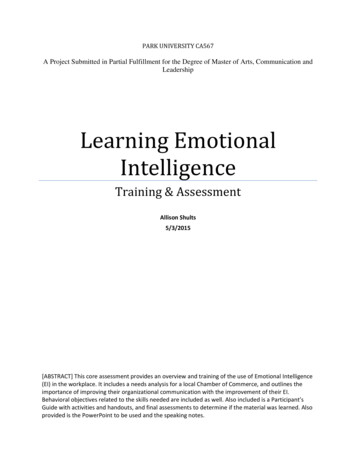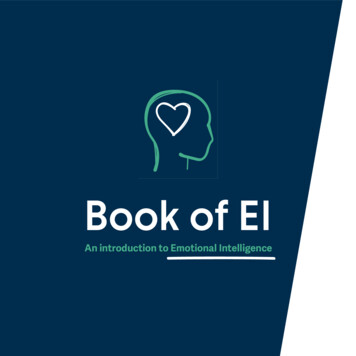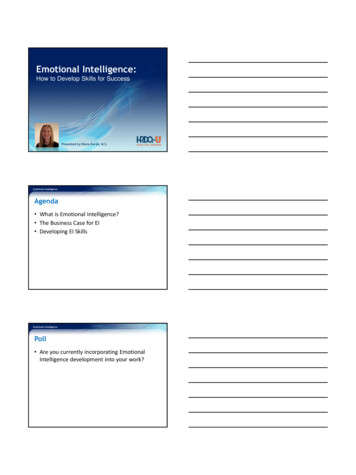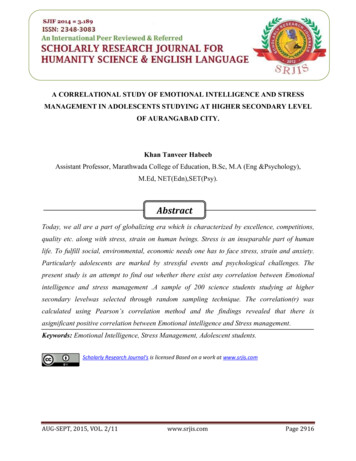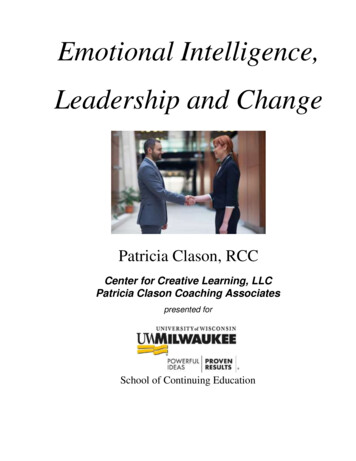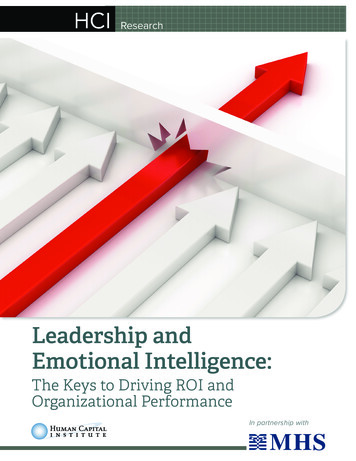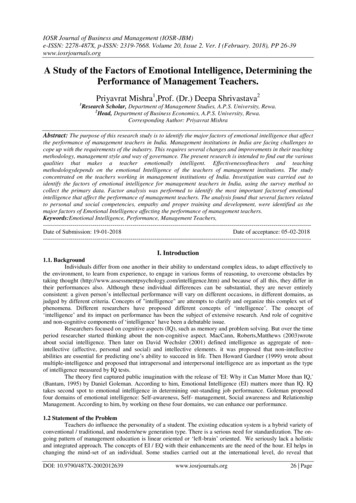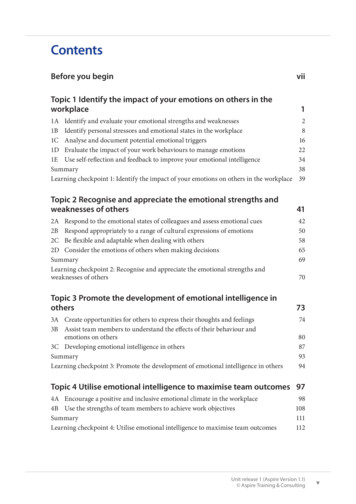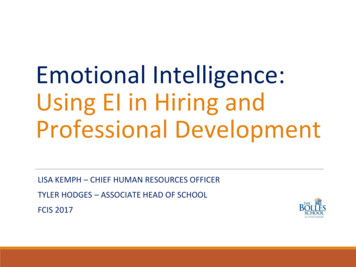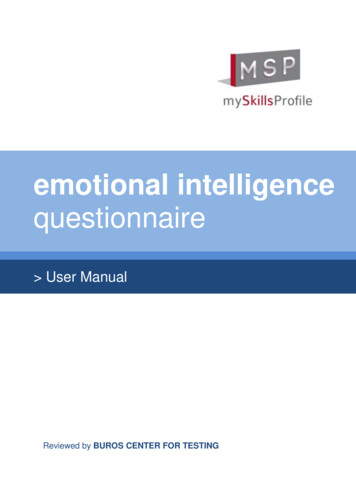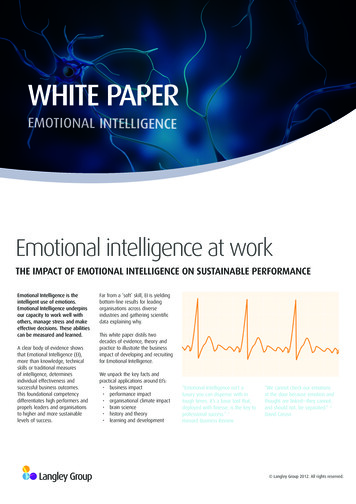
Transcription
WHITE PAPEREMOTIONAL INTELLIGENCEEmotional intelligence at workTHE IMPACT OF EMOTIONAL INTELLIGENCE ON SUSTAINABLE PERFORMANCEEmotional Intelligence is theintelligent use of emotions.Emotional Intelligence underpinsour capacity to work well withothers, manage stress and makeeffective decisions. These abilitiescan be measured and learned.A clear body of evidence showsthat Emotional Intelligence (EI),more than knowledge, technicalskills or traditional measuresof intelligence, determinesindividual effectiveness andsuccessful business outcomes.This foundational competencydifferentiates high performers andpropels leaders and organisationsto higher and more sustainablelevels of success.Far from a ‘soft’ skill, EI is yieldingbottom-line results for leadingorganisations across diverseindustries and gathering scientificdata explaining why.This white paper distils twodecades of evidence, theory andpractice to illustrate the businessimpact of developing and recruitingfor Emotional Intelligence.We unpack the key facts andpractical applications around EI’s: business impact performance impact organisational climate impact brain science history and theory learning and development“Emotional Intelligence isn’t aluxury you can dispense with intough times. It’s a basic tool that,deployed with finesse, is the key toprofessional success.” 1Harvard Business Review“We cannot check our emotionsat the door because emotion andthought are linked—they cannot,and should not, be separated.” 2David Caruso Langley Group 2012. All rights reserved.
WHITE PAPEREMOTIONAL INTELLIGENCEWHY DOES EMOTIONALINTELLIGENCE MATTER?The business case foremotional intelligenceLeadership andorganisational climateWe are working in increasinglycomplex and competitiveenvironments. Organisations andthe people in them are trying toachieve more with less resourcesand greater pressure.Gallup research highlights theimpact of leaders’ emotionalcompetencies on employeeengagement. Three critical factorswere identified: feeling cared for bya supervisor, receiving recognitionor praise, and believing theiremployer is concerned about theirdevelopment.4Many are challenged with engagingemployees and establishingcompetitive advantage during rapidchange and constant uncertainty.Raising productivity, integratingnew approaches and succeeding inglobal markets, demands greaterflexibility, cultural sensitivity andcollaboration. Those who createand sustain strong business resultsin this climate engage hearts andminds, managing complex, oftencompeting, agendas with savvyand awareness.From professional services toretail to manufacturing, EmotionalIntelligence skills are increasinglyseen as critical and strategic.Global organisations are buildingEmotional Intelligence (EI) intotheir workforces to ensure highperformance and enhance peoplesmarts.Solid research over two decadeshas demonstrated the businessimpact of developing andrecruiting for EI on leadership andindividual performance, employeeengagement, organisationalclimate, teamwork, sales andcustomer loyalty.EI has twice the power of IQ topredict high performance. 3In an ongoing study at IBM,emotional intelligence is drivingsignificantly higher employeeengagement levels.5 In anIranian car manufacturer, EIdirectly predicted the quality oforganisational climate.6 Positiveworkplace culture has been linkedto ethical behaviour--people areless likely to withhold effort orneglect job duties.7One foundation of emotionalcompetency—accurate selfassessment—was associatedwith superior performance inseveral hundred managers across12 organisations.8 In contrast,research by the Center for CreativeLeadership found the primarycauses of derailment in executivesinvolve low EI, particularly difficultyhandling change, poor teamworkand interpersonal relationships.9Two separate studies foundproject managers and technologyprofessionals with high EI improvedteamwork and managed conflictmore effectively.10Entrepreneurs and small businessowners using EI skills to createpositive cultures increased revenueand growth,11 while managerswho showed worry, frustrationand bewilderment underminedentrepreneurial motivation.12Financial performanceThe bottomline impact of emotionalintelligence is significant.PepsiCo generated 10% moreproductivity, 87% less turnover andover 1000% return on investmentby recruiting emotionally intelligentmanagers.13 One of the UK’slargest restaurant groups foundemotionally intelligent managersachieved 34% profit growth, lowerturnover and higher customersatisfaction.14 After supervisortraining at a manufacturer, losttime accidents reduced by 50%,formal grievances dropped andproductivity goals were exceededby 250,000.15Retention is an area where EI candramatically reduce costs. The USAirforce saved 190 million in highvalue training by screening for EIamong pararescuers.16 Successfulcandidates were more able to copewith and excel during demandingonboarding.Sales and customer loyaltyExtensive studies by the ForumCorporation on Manufacturing andService Companies found 70%of reasons customers left wereemotional and relationship factors.17Its no wonder EI is particularlyimpactful in sales and customercare.In a robust study at Sanofi-Aventis,salespeople trained in emotionalintelligence increased skills by18% and went on to out-sell peersby 12%, earning 2.2 million permonth and returning 6 for eachdollar invested.18After a year long project to buildEI skills and empower leadersto create a trust-based culture,Sheraton increased market share by24%, improved guest satisfactionand significantly reduced turnover.19A Government department focusingon EI competencies increasedrevenue by 53% in one year, andimproved customer satisfactionscores to 4.71 out of 5 among topclients.20At L’Oreal salespeople alreadydemonstrating high EI brought in 2.5 million more in net revenuethan those recruited usingtraditional criteria.21 In a nationalUS insurer, sales agents strongin key EI competencies such asself-confidence and empathy soldpolicies worth 114,000, comparedto 54,000 by weaker colleagues.22Experienced multinationalconsulting firm partners withhigh EI delivered 1.2 millionmore profit, resulting in a 139%incremental gain for the firm.23Individual performanceA recent London School ofEconomics study found highperforming traders are moreemotionally intelligent and makebetter decisions.24Among midwives and obstetriciansin a large hospital, EI stronglypredicted performance andeffective stress management,especially in leaders.25 An EI andstress management programmein a Motorola manufacturing plantboosted productivity by 93%.26 Langley Group 2012. All rights reserved.
WHAT DOES EMOTIONALINTELLIGENCE LOOK LIKE?Emotional intelligencein practiceStudies such as these provide clearevidence that higher levels of EI—inleaders, sales people, customerservice reps, influencers, advisors,professional service providersor anyone whose job involvesinteracting with people—increasesindividual and organisationaleffectiveness.In practice, people with emotionalintelligence skills are more ableto accurately assess situations,determine appropriate responsesand keep things in perspective.While some people naturally tune intowhat others feel and put them at ease,the good news is that EI can be taughtand developed.By better understanding andmeeting human needs, theybuild relationships that inspireproductivity and commitment.“Leaders who use their emotionalresources to foster engagement deliversignificant bottom-line results.”30Joshua FreedmanEmotional Intelligence helpspeople connect and communicateeffectively, make decisions, andmanage stress, pressure andconflict27. It enables people to instilconfidence and belonging in others,engage and influence acrossboundaries, and respond withsensitivity and care even whenchallenged.People with high EI are describedas “aware, authentic, empathic,expansive, resilient, empoweringand centred” rather than“disconnected, guarded, insensitive,limited, temperamental, indifferentand reactive”28.With insight into themselvesand others, they recognise theemotions that drive thinkingand behaviour, and use thatunderstanding to generate positiveoutcomes and mood. Attunedto emotions that can disruptengagement and productivity,they are able to convert fears andconcerns into opportunity andframe challenges constructively.“The higher a leader rises in theorganisation the more EI matters.”29Daniel GolemanCASE STUDYIncreasing emotional intelligencethrough leadership coaching and developmentHank*, Group Strategy Manager at a multinational pharmaceutical company, had beenadvised to improve his people skills or his job was on the line. Peers described hismanagement style as “my way or the highway”, and while it was efficient, it was notthe most effective strategy and had become personally draining.Initially skeptical about the emotional intelligence training his company mandated, hetook on the challenge of transforming his leadership and communication style.EIW coach Janet Langley introduced Hank to the Mayer-Salovey-Caruso EmotionalIntelligence (MSCEIT) framework. Using specific EIW tools, such as the mood meter,combined with a better understanding of body language and facial expressions, helearned to observe and pick up on emotional cues. More careful about his emotionalvocabulary and how it impacted others, he began to approach each conversation as arelationship opportunity. This transformed his ability to diffuse and preempt potentialconflict. He now develops a communication strategy to ensure successful outcomes forall important conversations.Building on his technical and strategic intelligence, these new emotional intelligencestrategies soon hotshot his career and opened doors. He now holds a C-level positionin a major retailer.* Names have been changed for confidentiality Langley Group 2012. All rights reserved.
WHITE PAPEREMOTIONAL INTELLIGENCEHOW LONG HAS THE CONCEPTOF EMOTIONAL INTELLIGENCEBEEN AROUND?The history ofemotional intelligenceEmotional intelligence principleshave been alluded to for centuries.Philosophers from Socrates andPlato to Buddha and Confuciusadvised regulating emotions andimproving social interactions forgreater mastery and influence.Emotions and their links tobehaviour and genetics weredebated over 250 years agowhen Charles Darwin cataloguedemotional expression in humansand animals.31 Even in the early1900s when cognitive intelligence(IQ) was first quantified, EdwardThorndike was defining SocialIntelligence as understanding andmanaging people.Emotional Intelligence researchbegan in earnest in the 1970s and80s, with psychologists Jack Mayerand Peter Salovey.Observing that smart people oftenmade very poor decisions, Mayerand Salovey realised conventionalmeasures of intelligence fellshort. They classified EmotionalIntelligence as a distinctintelligence, defining it as thebrain’s ability to process emotionalinformation.32Mayer and Salovey, togetherwith colleague David Caruso,developed the first scientificallyvalidated measure of EI ability, theNEED HIGH RES IMAGEMayer-Salovey-Caruso EmotionalIntelligence Test (MSCEIT), basedon their theoretical and empiricalresearch.Emotional Intelligence waspopularised by psychologist DanielGoleman in his 1995 best-sellerEmotional Intelligence: Why itmatters more than IQ.33In a robust review of brain scienceand literature, Goleman broadenedMayer and Salovey’s definition,attributing a large component ofpersonal and professional successto emotional competencies such asself-awareness, self-management,self-motivation, empathy andrelationship management.A third model was developed byReuven Bar-On, who described EIas a cross-section of interrelatedemotional and social competenciesand skills that impact intelligentbehaviour.34 Bar-On created a selfreport test, the Emotional QuotientInventory (EQ-i).Since then extensive research andhundreds of books have exploredEI’s applications to business,performance and relationships.Several tests, including theGoleman-based Emotional andSocial Competence Inventory (ESCI),can now measureemotional intelligence andemotional skills, traits andbehaviours. Genos EI Assessment,an Australian tool targets frequencyof EI behaviours in the workplace.EQ is an abbreviation of ‘emotionalquotient’ similar to IQ for ‘cognitiveintelligence’.EI is the abbreviation of emotionalintelligence used in academiccontexts.EI is scientifically validated andunique from cognitive ability. Langley Group 2012. All rights reserved.
HOW ARE EMOTIONSCRITICAL TO THINKINGAND SURVIVAL?The science ofemotional intelligenceModern neuroscience has turnedaround the way we think aboutemotions.We now know that emotionsplay a critical role in influencingand guiding our thinking andbehaviour—what we think, how wethink, how we make decisions andhow we act on them.In his influential 1994 bookDescartes’ Error: Emotion,Reason, and the Human Brain,neuroscientist Antonio Damasiodemonstrated that rational thinkingand decision-making depend oninput from emotions.35Decisions are never made‘unemotionally’ and actions arenever fully ‘rational’. “Far frominterfering with rationality,” heasserts, “the absence of emotionand feeling can break downrationality and make wise decisionmaking almost impossible.”36In fact, the sense that somethingis ‘real, true, and important’ comesnot from the reasonable neocortexbut from the emotion centers ofthe brain’s limbic cortex.37The limbic system is designed toprocess stimulus and experienceleaving our cognitive centres freefor higher order thinking.Even when we feel we have madea rational decision, chances are ouremotions made it first. Reasonsare then established to justify ourinstinctive gut feeling.Emotions contain data aboutourselves, other people and theworld around us. They attributevalue to our choices, enabling usto navigate daily life safely andeffectively.Remaining open to feelings givesus valuable early data pointsthat help us think and act moreintelligently.According to expert Paul Ekman,emotions evolved for their adaptivevalue in dealing with fundamentallife tasks.38 Emotions occur quicklyand automatically, usually withoutconscious thought. Their primaryfunction is to mobilize the organismto deal quickly with importantinterpersonal or threatening events.Imagine, for example, you’re in ahurry driving to work. A changein the environment—the soundof a police car siren—triggers arapid emotional response. Theemotion makes you pay attentionand generates thought. You realiseyou have been speeding, possiblyendangering the lives of others.This motivates behaviour and youslow down.This adaptive theory of emotionsshows how critical emotions are toour survival.When our pre-frontal (thinking)cortex and limbic (emotional)system are not communicatingeffectively, we may behaveemotionally rather thanintelligently, or make logicalassessments without consideringthe emotional implications of ourbehaviour.Emotional intelligence is aboutharnessing these two aspects toensure we are managing our ownemotions rather than allowing ouremotions to manage us.Learning how to use emotionsintelligently empowers us torespond effectively, rather thanreactively. By increasing our rangeof emotional intelligence strategieswe can achieve more positiveoutcomes for ourselves and thepeople around us.“Emotions can lead to our worstdecisions or our best ones. Thedifference is emotional intelligence.”39Joshua FreedmanTHE EMOTIONAL BRAINThe limbic system Langley Group 2012. All rights reserved.
WHITE PAPEREMOTIONAL INTELLIGENCEHOW DO WE RECOGNISEEMOTIONS?The theory of emotionsEmotions are not chaotic and followpredictable patterns, rules andvisual cues.Even micro-expressions—thosebrief, involuntary facial movementsthat indicate what we are reallyfeeling and thinking—can bestudied and learned.EMOTION v MOODEMOTIONAL INTENSITYHIGH ENERGYMood - noise(no external cause)NEGATIVEFacial recognition expert PaulEkman proposes six primaryemotions—happiness, fear, anger,sadness, disgust and surprise.40Emotion - signal(external cause)These emotions have universalmeanings and are found acrosscultures and generations.A smile shows happiness in allareas of the world, though whatcauses this smile will vary fromperson to person, group to group.Within cultures, organisations andgroups, collectively held norms—implicit or explicit—can shape thetype of emotions that are allowedand displayed. Disturbingly, angeris the most frequently expressedemotion in US workplaces (53%),and joy the least (19%).41A complex and subtle range makesup the full spectrum of humanemotional experience.Robert Plutchik designed a wheelof emotions, where primaryemotions can be expressed atdifferent intensities and blend toform different emotions.42Emotions can also be mappedaccording to the energy levelbehind them: anger or excitementare high energy; sadness andserenity are low energy.The richer and more nuanced ouremotional vocabulary, the morewe are able to consciously reflecton and take charge of emotionalexperience.POSITIVELOW ENERGYThis happens literally in the brain.Recent fMRI (functional magneticresonance imaging) studies showthat labelling emotions actuallyreduces reactivity in the limbicsystem.44Emotions are distinct fromfeelings and moods. Emotions areexperienced as specific responsesto events or objects—real orimagined—that motivate behaviour.Moods tends to be pervasive,global, generalised states thatinfluence events and are lessresponsive to stimuli.43As such, emotions act as signals;moods are experienced asbackground noise.Feelings are the physiologicalsensations that inform how weinterpret and describe emotionalexperience.Robert Plutchik Langley Group 2012. All rights reserved.
A definition of emotionalintelligenceDaniel Goleman defines EmotionalIntelligence as:.the capacity for recognisingour own feelings and those ofothers, for motivating ourselves,and for managing emotionswell in ourselves and in ourrelationships.45According to Mayer and Salovey,EI involves reflectively regulatingemotions to enhance emotionaland intellectual development.46They break this down into specificabilities based on the wayemotions work in the brain. Theirdefinition is regarded by scholars asthe standard:.the ability to monitor one’sown and others’ feelings andemotions, to discriminate amongthem, and to use this informationto guide one’s thinking andaction.47perceivingemotionsusingemotionsThe Mayer-Salovey definitionhighlights four different abilities.Perceiving Emotions—accuratelyrecognising how you and othersare feeling. This includes the abilityto read another person’s facialexpressions to better understandwhat they are experiencing.Using Emotions—sensing andgenerating emotions andintegrating them strategicallyto enhance thinking, reasoning,problem solving and creativity.Understanding Emotions—understanding the complexityof emotions and their causes,including why you and others feeland react the way they do andhow these emotions are likely tochange over time.managingemotionsunderstandingemotionsManaging Emotions—drawing onemotional data about yourself or othersto respond effectively rather thanreactively, and designing strategiesthat achieve positive outcomes. Thisincludes managing outbursts, calmingfears and behaving appropriately toshow care and understanding.MAXIMISING EMOTIONAL IMPACTBuilding a positive emotional climate in organisations and teamsWhile people generally considerthemselves positive, due to oursurvival mechanisms we have aninnate negativity bias that givesmore weight to negative emotionsand states.Teams that maintain a 5:1 ratioof positivity to negativity in theirinteractions perform optimally andare more profitable.48Positive emotions is critical toexplaining outcomes acheived bymanagers in organisations. Researchshows impact on performance,decision making, turnover, prosocialbehaviour, negotiation and conflictresolution behaviour, groupdynamics, and leadership.49Positive psychologist BarbaraFredrickson suggests thatexperiencing certain positiveemotions—joy, interest,contentment, pride and love—broadens our repertoire of habitualthoughts and actions.50According to Fredrickson’sBroaden-and-Build-Theory,increasing positive emotions buildsenduring personal resources,enabling us to manage stressfulsituations and propelling us in‘upward spirals’ toward optimalperformance, wellbeing andgrowth.Positive emotions also lessen theresonance of negative experienceand provide a powerful antidote toanxiety.51The capacity to selectively generateemotions--positive, neutral andnegative--to suit the situationand boost resilience in self andothers is fundamental to emotionalintelligence.Positive emotions encourage openmindedness and flexibility, enablingus to generate more creativesolutions, connect with others, takeon critical feedback and persist inachieving goals.Neutral or slightly negative emotionsnarrow attention and help us detectand correct mistakes, assess risksand evaluate plans, resulting in morecareful, systematic and better qualityarguments.A leader who is aware of theiremotional impact and able topositively influence the mood oftheir team by building and sustainingpositive mood will help shapeorganisational climate, increasingperformance.This is particularly relevantwhen considering the powerfuleffect of ‘emotional contagion’within groups—both positive andnegative.52“Positive emotions can spreadthroughout organisations, amongmembers, and to customers. [and]fuel individuals to contribute to theeffectiveness of their organisation.”53Barbara Fredrickson
WHITE PAPEREMOTIONAL INTELLIGENCEHOW CAN WE BECOME MOREEMOTIONALLY INTELLIGENT?Developing emotionalintelligencePeople often assume thatemotional intelligence is justsomething you are born with—some people naturally tune intowhat others feel and put them atease, and others just don’t operatethat way.It is true that genetic predispositioncan make some people moreemotionally intelligent thanothers. How our early caregiverstaught us to comfort each otherand ourselves, and to control ourimpulses, also played a role.A Johnson & Johnson study wasamong the first to establish thatemotional competencies can bedeveloped through systematictraining.54Emotional Intelligence trainingprogrammes have been shown toimprove EI and performance amongfinancial advisors, retail managers,HR consultants, technical expertsand manufacturing staff to namea few.55 Importantly, these abilitiesare retained over many years.When results are discussedwith a coach or other qualifiedprofessional and integrated intopersonal development plans,individuals and teams can gaindramatic self-awareness andtangible strategies that can beintegrated into work and daily life.At emotional intelligenceworldwide, our targeted andindividualised EI programmesemphasise practical benefits andempower participants with tools tocontinue practicing, learning andreinforcing new skills.The good news is that EI can belearned and developed in adultsover time.The most effective traininginterventions integrate EmotionalIntelligence into organisationalculture.Humans are geared to life-longlearning and growth. Our braincells are continually forming newconnections and restructuring ourperceptions and physiology.These foundational skills canbe instilled as building blocksupon which leadership or othercompetencies can be moreeffectively developed.This process of neuroplasticityhappens thousands of times a day,giving us enormous potential tochange if we put awareness, effortand commitment into making ithappen.Best results are gained whencoaching supports training andparticipants are motivated byconnecting with the personal andprofessional benefits that greateremotional intelligence will deliver.Emotional intelligence may be themost important quality we canlearn and practice to continue ourgrowth and capacity to positivelyimpact others.Neurogenesis—the brain’s ability togrow new cells even in adulthood—is linked to learning.Assessing current levels ofemotional intelligence accuratelythrough an EI assessment tool suchas Mayer-Salovey-Caruso EmotionalIntelligence Test (MSCEIT) orGenos EI Assessment is also highlyvaluable.“Our genetic heritage endows eachof us with a series of emotionalset-points that determinesour temperament. But the braincircuitry involved is extraordinarilymalleable; temperament isnot destiny.”56Daniel GolemanLearning to be more intelligentwith emotions is not a quickfix. Instead it offers deeper andmore sustainable results that gobeyond personal effectiveness andsuccess to measurably improve thefiscal and psychological health oforganisations. Langley Group 2012. All rights reserved.
Citations and resources1.2.3.4.5.6.7.8.9.10.11.12.Harvard Business Review (2003).Breakthrough ideas for tomorrow’sbusiness agenda April.Caruso, D. A practical guideto the MSCEIT. Prepared forMHS Emotional IntelligenceAssessments and Solutions.Available at http://www.mhs.com/ei.Mount, G. (2006). The roleof emotional intelligence indeveloping international businesscapability: EI provides traction. In V.Druskat, F. Sala & G. Mount (Eds),Linking Emotional Intelligence andperformance at work. Mahwah,NJ: Lawrence Elbaum Associates,97-124.Buckingham, M. & Coffman,C. (1999). First, Break All theRules: What the world’s greatestmanagers do differently. NewYork: Simon & Schuster.Genos (2012). EmotionalIntelligence and employeeengagement: IBM. Case Study athttp://www.genosinternational.com.Momemi, N. (2009). The relationbetween managers’ emotionalintelligence and the organizationalclimate they create. PublicPersonnel Management, 38(2):3548.Kidwell, R. & Valentine, S. (2008).Positive group context, workattitudes, and organizationalmisbehavior: The case ofwithholding job effort, Journal ofBusiness Ethics. Published Online4 June.Boyatzis, R. (1982). TheCompetent Manager: A model foreffective performance. New York:John Wiley and Sons.Chernis, C. (2003). The BusinessCase for Emotional Intelligence.Prepared for Consortium forResearch on Emotional Intelligencein Organizations at http://www.eiconsortium.org/Clarke, N. (2010). Emotionalintelligence and its relationship totransformational leadership andkey project manager competences.Project Management Journal,41(2):5-20. Godse, A., &Thingujam, N. (2010). Perceivedemotional intelligence andconflict resolution stylesamong information technologyprofessionals: Testing themediating role of personality.Singapore Management Review,32(1):69-83.Ozcelik, H., Langton, N., & Aldrich,H. (2008). Doing well and doinggood: The relationship betweenleadership practices that facilitatea positive emotional climateand organizational performance.Journal of Managerial Psychology,23(2):186-203.Brundin, E., Patzelt, H., herd, D. (2008). Managers’emotional displays andemployees’ willingness to actentrepreneurially. Journal ofBusiness Venturing, 23(2):221-243.McClelland, D. (1998). Identifyingcompetencies with behaviouralevent interviews. PsychologicalScience, 9(5):331–340.BarOn, R. & Orme, G. (2003).Reported in Orme & Langhorn,Lessons learned fromimplementing EI programs,Competency & EmotionalIntelligence, (10)32-39.Pesuric, A., & Byham, W.(1996). The new look inbehavior modeling. Training andDevelopment, July 25-33.Bar-On, R. (2010). New US AirForce Study: EQ to Save 190Million. Six Seconds blog, Sep 20at rcestudy-eq-saves-millions.Whiteley, R. (1991). The CustomerDriven Company: Moving from talkto action. Reading, Massachusetts:Addison-Wesley, 9-10.Jennings, S., & Palmer, B. (2007).Enhancing sales performancethrough Emotional Intelligencedevelopment, Organisations &People, 14(2).Freedman, J. (2003). Case Study:Emotional Intelligence at theSheraton Studio City Hotel. SixSeconds.Freedman, J. (2006). Case Study:GSA Region 3. Six Seconds.Spencer & Spencer (1993);Spencer, McClelland, & Kelner(1997). Cited in Cherniss (2003).Hay/McBer Research andInnovation Group (1997). Cited inGoleman, D. (1998). Working withEmotional Intelligence. New York:Bantam.Boyatzis, R. (1999). Presentationto the Linkage Conference onEmotional Intelligence, Chicago,IL, Sep 27.Fenton-O’Creevy, M., Soane, E.,Nicholson, N. & Willman, P. (2011).Thinking, feeling and deciding:The influence of emotions on thedecision making and performanceof traders. Journal of OrganizationalBehavior 32(8):1044–1061.Fariselli, L., Freedman, J., Ghini,M. & Valentini, F. (2008).Stress, Emotional Intelligence &Performance in Healthcare. SixSeconds.HeartMath (2003). Reported in J.Freedman (2010). The BusinessCase for Emotional Intelligence.Six Seconds available at http://www.6seconds.org.Lopes, P., Côté, S., & Salovey,P. (2006). An ability 43.44.of emotional intelligence:Implications for assessment andtraining. In V. U. Druskat, F. Sala, &G. Mount (Eds.), Linking emotionalintelligence and performance atwork. Mahwah, NJ: LawrenceErlbaum Associates, 53-80.Genos (2010). A compellingbusiness case for EmotionalIntelligence. Available at http://www.genosinternational.com.Goleman, D., Boyatzis, R. & McKee,A. (2002). Primal leadership:Realizing the power of emotionalintelligence. Boston, MA: HarvardBusiness School Publishing.Freedman, J. (2010).Darwin, C., Ekman, P. & RogerP. (1998). The Expression of theEmotions in Man and Animals.Oxford: Oxford University Press.Salovey, P., & Mayer, J. (1990).Emotional intelligence.Imagination, Cognition andPersonality 9, 185–211.Goleman, D. (1995). EmotionalIntelligence: Why it matters morethan IQ Bantam.Bar-On, R. (2000). Emotional andsocial intelligence: Insights fromthe Emotional Quotient Inventory(EQ-i). In R. Bar-On and J. Parker(Eds.), Handbook of emotionalintelligence: Theory, development,assessment and applicationat home, school and in theworkplace. San Francisco: JosseyBass, 363-88.Damasio, A. (1994). Descartes’Error: Emotion, Reason, and theHuman Brain. Harper.Ibid.MacLean, P. (1990). The TriuneBrain in Evolution: Rol
Emotional Intelligence is the intelligent use of emotions. Emotional Intelligence underpins our capacity to work well with others, manage stress and make effective decisions. These abilities can be measured and learned. A clear body of evidence shows that Emotional Intelligence (EI), more than knowledge, technical skills or traditional measures
